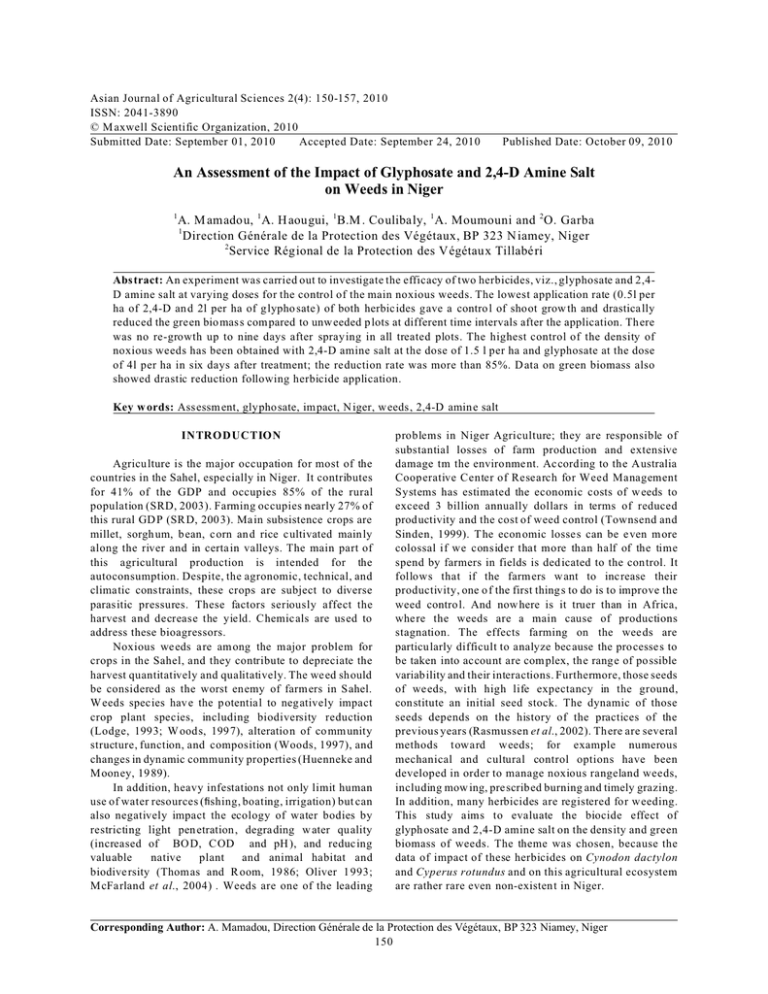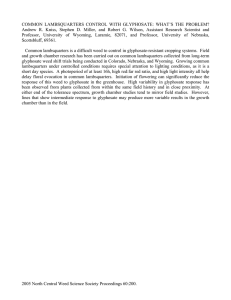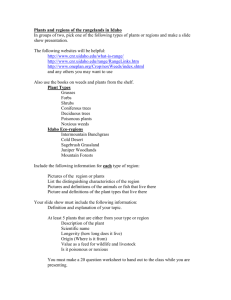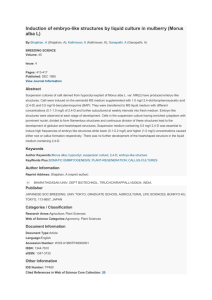Asian Journal of Agricultural Sciences 2(4): 150-157, 2010 ISSN: 2041-3890
advertisement

Asian Journal of Agricultural Sciences 2(4): 150-157, 2010 ISSN: 2041-3890 © M axwell Scientific Organization, 2010 Submitted Date: September 01, 2010 Accepted Date: September 24, 2010 Published Date: October 09, 2010 An Assessment of the Impact of Glyphosate and 2,4-D Amine Salt on Weeds in Niger 1 A. M amadou, 1 A. H aougui, 1 B.M . Coulibaly, 1 A. Moumouni and 2 O. Garba 1 Direction Générale de la Protection des Végétaux, BP 323 N iamey, Niger 2 Service Régional de la Protection des Végétaux Tillabéri Abstract: An experiment was carried out to investigate the efficacy of two herbicides, viz., glyphosate and 2,4D amine salt at varying doses for the control of the main noxious weeds. The lowest application rate (0.5l per ha of 2,4-D an d 2l per ha of glypho sate) of both herbicides gave a contro l of shoot grow th and drastically reduced the green bio mass com pared to unw eeded p lots at different time intervals after the application. Th ere was no re-growth up to nine days after spray ing in all treated plots. The highest control of the density of noxious weeds has been obtained with 2,4-D amine salt at the dose of 1.5 l per ha and glyphosate at the dose of 4l per ha in six days after treatment; the reduction rate was more than 85%. D ata on green biomass also showed drastic reduction following herbicide application. Key w ords: Assessm ent, glyphosate, impact, N iger, w eeds, 2,4-D amine salt INTRODUCTION Agriculture is the major occupation for most of the countries in the Sahel, especially in Niger. It contributes for 41% of the GDP and occupies 85% of the rural population (SRD, 2003). Farming occupies nearly 27% of this rural GD P (SRD, 200 3). Ma in subsistence crops are millet, sorgh um, b ean, corn an d rice cultivated mainly along the river and in certa in valleys. The main part of this agricultural production is intended for the autoconsumption. Despite, the agronomic, technical, and climatic constraints, these crops are subject to diverse parasitic pressures. These factors seriously affect the harvest and decrease the yield. Chemic als are used to address these bioagressors. Noxious weeds are among the major problem for crops in the Sahel, and they contribute to depreciate the harvest quantitatively and qualitatively. The weed should be considered as the worst enemy of farmers in Sahel. W eeds species hav e the potential to negatively impact crop plant species, including biodiversity reduction (Lodge, 1993; W oods, 1997), alteration of co mm unity structure, function, and composition (Woods, 1997), and changes in dynamic community properties (Huenneke and Mooney, 19 89). In addition, heavy infestations not only limit human use of water resources (Wshing, boating, irrigation) but can also negatively impact the ecology of water bodies by restricting light pen etration, degrading w ater quality (increased of BO D, COD and pH ), and reducing valuable native plant and animal habitat and biodive rsity (Thom as and R oom, 19 86; Oliver 1993; McFarland et al., 2004) . Weeds are one of the leading problems in Niger Agriculture; they are responsible of substantial losses of farm production and extensive damage tm the environme nt. Ac cording to the Australia Cooperative Center of Research for Weed Management Systems has estimated the economic costs of w eeds to exceed 3 billion annually dollars in terms of reduced productivity and the cost of weed control (Townsend and Sinden, 1999). The econ omic losses can be even m ore colossal if we consider that more than half of the time spend by farmers in fields is ded icated to the control. It follows that if the farm ers w ant to inc rease their productivity, one o f the first thing s to do is to improve the weed contro l. And now here is it truer than in Africa, whe re the weeds are a main cause of productions stagnation. The effects farming on the wee ds are particularly difficult to analyze because the processe s to be taken into account are com plex, the rang e of po ssible variability and their interactions. Furthermore, those seeds of we eds, with high life expectancy in the ground, constitute an initial seed stock. The dynamic of those seeds depends on the history of the practices of the previous years (Rasmussen et al., 2002). Th ere are several methods toward weeds; for example numerous mechanical and cultural control options have been developed in order to manage noxious rangeland weeds, including mow ing, prescribed burning and timely grazing. In addition, many herbicides are registered for weeding. This study aims to evaluate the biocide effect of glyph osate and 2,4-D amine salt on the density and green biomass of weeds. The theme was chosen, because the data of impact of these herbicides on Cynodon dactylon and Cyperus rotundus and on this agricultural ecosystem are rather rare even non-existent in Niger. Corresponding Author: A. Mamadou, Direction Générale de la Protection des Végétaux, BP 323 Niamey, Niger 150 Asian J. Agric. Sci., 2(4): 150-157, 2010 3 sampling points (1m²); the distance of sampling points is 1 m (F ried, 2007, m odified ). The assessment is made in 1m borders of the plot of land to avoid interferences, and for 1 m of the center to avoid its effect. It is worth noting that any weed presenting necrosis or other symptoms due to the herbicide, is not taken into account in the density assessment. With the aim of strengthening the method of weed estimation, we coupled with the first method; a second sampling method which consisted in launching three times at rando m in every elementary plot of 1 m² quadrat placed on the ground and counting the number of plants (Gleason, 1920; Mosley et al., 1989; Sorrells and Glenn, 1991). B efore spraying , we first verified the density of weeds in all experimental plots, to see if our elementary plots are homogeneous or not before the trial. MATERIALS AND METHODS Experimental site and design: The field trial was carried out in the suburban district of Tillabéri (14º25!71 N, 01º42!27 W), in the Northwest of Niamey, in the “canton” of Sakoira. The suburban district of Tillabéri is 104 245 km² (Larwanou et al., 2005). This area is choosen because the noxious weeds were a main problem to agriculture. The region of Tillabéri belongs to the Sahelian savannah. The annual rainfall recorded in 2009 by the syno ptic station of Tillabéri is 259.8 mm. The main part of the rainfall was recorded between July and August; these two months represent 52% of the total rainfall. During the field monitoring from 12 to 25 July, no rain was recorded. The temperature ranged from 32 to 38ºC. The experimental design used is a complete random block (CRB). The distance between blocks is 10 m and 10 m between the experim ental units which are squares of 25 m². Nine treatments were carried: 1) Glyphosate 41 % at the amount of 2 l per ha (Glyph1); 2) Glyphosate 41 % at the dose of 3 l per ha (Glyph2); 3) Gly phosate 41 % at the dose of 4l per ha (G lyph3 ); 4) 2,4-D amine 720 g/L SL at the dose of 0.5l per ha (2,4-D1); 5) 2,4-D amine 720 g/L SL at the dose of 1l per ha (2,4-D2); 6) 2,4-D amine 720 g/L SL at the dose of 1.5l per ha (2,4-D3); 7) Londax (Bensulfuron methyl) at 80 g/ha ; 8) Kalach 360 SL (Glyphosate 360 g/L) at the dose of kg/ha and 9) the con trol. T h e L onda x (selec tive) an d K ala ch (nondiscriminatory herbicide) are the references. Assessment of the weeds green b iomass: The weeds green biom ass (g/m 2 ) is calculated before (D ay 0) and after treatme nt (6 D AT ). In each plot, 3 quadrats were randomly chosen for sampling. In ev ery quad rat (1 m²), all the weed is noted, washed there delicately abun dantly in the tap water to clear the ground, and w eighe d. W e only sampled the most widely distributed species. Data analysis: The analysis of the variance (ANOVA) was applied followed by Student-N ewman-Keuls multiple comparison of means if the null hypothesis is rejected at "#0.05. The statistical comparison is based on the BACI method (Before- After- Co ntrol- Impact) (StewartOaten et al., 1992, 2002; Underwood et al. 1991, 1992, 1994; Bence et al., 1996). The values expressed in abso lute numbers were transformed by the relation y = Trea tmen t: The Glyphosate an d 2,4-D amine salt (aqueous herbicidal solution) were applied in total coverage using standard equipment EC application. For this, the spray vo lume was wo rked out after calibration and the herbicide quantities were calculated as per the experiment protoc ol. The emission h eight is 50 cm. Treatments are made o n weeds at the ad vanced stage. A ll the treatments were made between 8-1 0 am while temperature is lower than 35ºC, and the wind speed ranged be tween 1.5 -2 m/s. The nominal doses recommended by the firm were really applied (nominal doses = real doses). This experimental protocol was developed according to the specific protocol for the biological evaluation of weed of the Sahelian Comm ittee of Pesticides. to homogenize the variances and insure a norm ality of the distributions unbalanced towards the right (Sokal and Rholf, 198 1, 199 5). W e use Minitab 14.0 software for data analysis. RESULTS AND DISCUSSION Weed density pre-spray: Before spraying, we estimated the level of infestation in all experimental plots, in order to verify the homo geneity of our sites. T he statistical analy sis of the results reveals that there is no significant difference between the expe rimen tal plots composing the site which received 2,4-D amine salt (p>0.05); this is the same for the site treated with the glyp hosa te; all the sites are homogenous before the spraying. Effect of Glyphosate and 2,4-D amine salt effect on weeds: The follow-up of the weed density is made before (these observation s are essentially intended to be able to arrange numbers of information related to the different experimental plots pre-spray) (Day 0) and after the treatments: 3 DAT (three days after treatment), 6 DAT (six days after treatment) and 9 DAT (nine days after treatment). In each interval of time , we assess in all experimental plots the density of w eed (plants per m 2 ). The evaluation of the density is made along diagonals on Effect of Glyphosate on the weeds density: Figure 1 indicates the structure and composition of noxious weeds in the Site 1, which received the Glyphosate treatment. The Fig. 2 demonstrates that the Glyphosate had a harmful effect on the main weed. Three days after treatment, high density reduction is obse rved in all herbicide treated experimental plots compared to the unw eede d plots. All glyphosate an d 2,4-D -treated plants 151 Asian J. Agric. Sci., 2(4): 150-157, 2010 Tab le 1: M ean of rate redu ction (±S E) o f w eed s de nsity after th e sp rayin g of the g lyph osa te Trea tmen ts ---------------------------------------------------------------------------------------------------------------------------------------------------Day after spraying 2l per ha 3l per ha 4l per ha Kalach* Control 3 DAT 49.96 b ±3.09 59.32 b ±6.42 72.50 a ±2.87 53.94 b ±2.52 5.77 c ±3.02 6 DAT 81.28 b ±3.76 87.42 b ±3.57 91.73 a ±2.87 84.70 b ±2.57 19.07 c ±2.99 Va lues ( mea n±S D; N = 24 ) not sha ring the sa me letter is sign ificantly diffe rent (p < 0.05), *: reference herbicide Table 2: Mean of reduction rate (±SE) of weeds density after the 2,4-D spray Treatment ---------------------------------------------------------------------------------------------------------------------------------------------------Day after spraying 0.5l per ha 1l per ha 1.5 per ha Londax* Control 3 DAT 34.47 a ±1.98 36.76 a ±10.56 60.34 b ±5.87 9.93 c ±11.32 10.95 c ±3.88 6 DAT 66.16 b ±2.82 91.11 a ±0.28 95.33 a ±0.20 25.16 c ±8.23 3.85 d ±8.65 Va lues ( mea n±S D; N = 24) not sharing the same letter is significantly different (p<0.05), *: reference herbicide rates (0.45 to 3.60% solution mixed). Th akur et al. (1993) also observed that glyphosate and 2,4-D (1.0 and 1.5 kg/ha) killed purple nutsedge and checked regeneration up to 360 days after spraying. The statistical analysis at 3 DAT show ed that treatments are significant F(4/10) = 25.21 p = 0.001. According to the Test of Sudent-Newman-Keuls, the glyph osate applied to the dose of 4l per ha was classified in a homogeneous group, treatments glyphosate in the dose of 3l per ha, glyphosate at the dose of 2l per ha and the kalach (reference herbicide) were gro uped in the same homogeneous class, thu s they have a rather similar behavior towards noxious weeds according to our results; the control is in another different class. With regard to efficiency, we note that the glyphosate at the dose of 4l per ha reduced drastically the w eeds density com pared to the other doses. At 6 DAT, they are the same observations as previously. Fig. 1: Composition and structure of noxious weeds in the site treated by Glyphosate displayed herbicide injury symptoms following chemical application. Yellowing and burning, were noted on 18 to 40% of plant tissues as early as 3 DAT. Symptoms progressed over time for all glyphosate and 2,4-D treatments. At 3 DAT, the weed reduction rate obtained acco rdingly to the control are respectively 49.96±3.09% for Glyphosate at the dose of 2l per ha; 59.32±6.42% for the glyphosate at the dose of 3l per ha; 72.50±2.87% for the glyphosate at the 4l per ha and 53.94±2.52% for the kalach (reference) (Fig. 2; Table 1). This density continued to increase and reach more than 80% at 6 DAT (Fig. 2; Table 1). At 9 DAT, the experiment was stopped especially because there we re no weeds in the glyphosatetreated plots compared to the control. Regarding the impact of glyphosate on noxious weeds, our results agree with Wndings by Ssegawa (2007); he obtained 55% of reduction on w eeds density after spraying of glyphosate. The negative impact of glyphosate was also recorded by Nelson et al. (2001), their results of outdoor herbicide trials showed that 8.97 kg/ha glyphosate mixed with a nonionic surfactant, controlled 99% of giant salvinia 42 days after treatment. In the USA, Nelson et al. (2007) demonstrated that 14 D AT , treatme nt with either 4.48 or 8.96 kg/ha gly phosate controlled 82.5 to 94% of giant salvinia whereas 2.24 k g/ha g lypho sate co ntrolled only 65 to 68% of sprayed p lants. In laboratory studies, Fairchild et al. (2002) reported signiWcant control of giant salvinia following glyphosate application ov er a broad range of Effect of 2,4-D on the weeds density: The main noxious weeds of site 2 are illustrated in the Fig. 3. The Fig. 4 shows that different application rate of 2,4-D can be used as chemical weed killer specially for Cyperus rotundus in particular according to the contro l. At 3 DAT, we note a high density reduction in any treated experimental plots, compared to the unweeded check where this den sity increased. The density reduction at 3 DAT, was 34.47±1.98% for 2,4-D applied at 0.5l per ha; 36.76±10.52% at 1l per ha and 60.34±5.87% at 1.5l per ha, while we noted with the londax a rate of 10.95±3.88% reduction (Table 2). At 6 DAT, the rates were respectively 66.16±2.82% with 2,4 D1 (2,4-D at the dose of 0.5l per ha); 91.11±0.28% for 2,4 D2 (2,4-D at the dose of 1l per ha), and 95.33±0.20% for 2,4 D3 (2,4-D at the dose of 1.5l per ha) (Table 2). These results confo rm w ell with previous studies conducted by Sheley et al. (2004) in the USA, about a significant effect of 2,4-D on the noxious weeds. Jonathan et al. (2004 ) noted a significant de nsity reduction of the weeds after ap plication of 2,4-D at 1.6 kg/ha and the sugarcane yields w ere greater compa red to the unweeded check. Our study confirms several studies (Hammerton, 1974; Hawton et al., 1992; Ameena and 152 Asian J. Agric. Sci., 2(4): 150-157, 2010 Fig. 2: Effect of glyphosate on the density of weeds before and after treatment. The arrow indicates the day after treatment where the density is null. The Fig. 1 denotes the density of noxious weeds in the treated plots with 4l per ha of glyphosate and the untreated plots Table 3:Impact of 2,4-D on green biomass of Cyperus rotundus after spraying Trea tmen ts 3 DAT 6 DAT Control 0.48 a ±1.11 12.04 a ±0.19 b 2,4-D at 0.5l per ha 1.37 ±3.41 40.43 b ±1.24 c 2,4-D at 1l per ha 16.91 ±0.23 77.83 c ±4.15 2,4-D at 1.5l per ha 35.21 d ±2.15 90.94 d ±3.32 Londax 4.13 e ±3.17 7.28 e ±0.18 Values (me an± SD ; N = 36) not sharing the sa me le tter are s ignif ican tly different (p<0.05) dose of 1.5l per ha in the same homogeneous class; the control, the londa x and the 2,4 D at application rate o f 0.5 l per ha belong to three different groups. According to our results, the highest reduction is observed with the application rate of 1 L/ha as well as 1.5l per ha. The londax had no considerable effect on Cyperus rotundus, the most dominant noxious weed. Also the experiment was stopped at 9 DAT, because the density of weeds in the 2,4-D-treated plots is very low com pared to control plots. Fig. 3: Composition and structure of noxious weeds in the site treated by 2,4-D amine salt Sansamma, 2004) on the negative impact of 2,4-D on Nutgrass (Cyperus rotundus). Three days after spraying, there was significant treatment effect on the density F(4/10) = 40.85 p = 0,001. According to the T est of Sudent-New man-K euls (SN K), 2,4-D applied at the dose of 0.5l and 1 L/ha were classified in a homogeneous group, so no significant difference between these two doses; treatments 2,4 D at the dose of 1.5l per ha belongs to a different class; the londax (reference product) and the control were grouped in the same homogeneous class, thus they have a rather similar behavior towards weed. In terms of efficiency, we note the dominance of 2,4-D at the dose of 1.5l per ha compared to the other application rate. At 6 DA T, the d ata analy sis shows a significant difference of treatments on weed density F(4/10) = 429.80 p = 0.001. The SN K test grouped 2,4-D at the dose of 1l per ha and 2,4-D at the Effect of 2,4-D on the green biomass of weeds: Figure 5 indicates the effect of the various doses of 2,4-D amine salt on the green biomass at different time intervals. From 3 DAT to 6 DAT, we observed a decay of the green biomass in the treated plots compared to the control wh ere this biom ass increased. The strongest reduc tions were noted at 6 DAT , but the 2,4-D at the dose of 1,5l per ha gave strongest reduction. The londax had no effect on the green biomass compared to the various application rate of 2,4-D. W ith regard to day 0 values and by making a correction, we observe in Table 3 that the strong reduction 153 Asian J. Agric. Sci., 2(4): 150-157, 2010 Fig. 4: Effect of 2,4-D on the weeds density before and after treatment. The arrow indicates the day after treatment where the density is null. The Fig. 3 denotes the density of noxious weeds in the treated plots with 2,4-D at 1.5l per ha and in the untreated plots Fig. 5: Effect of 2,4-D on green biomass of Cyperus rotundus before and after treatment. The number above the figure denotes the density of noxious weeds in the treated plots with 2,4-D at 1.5l per ha (2,4 D3) and in the untreated plots rate of the biomass was noted in 6 DAT. And so we obtained a reduction of 90.94±3.32% of the green biomass with the 2,4-D at the dose of 1.5l per ha; 77.83±4.15% with the dose of 1 L/ha and 40.43±1.24% with the dose of 0.5l per ha. This conclusion sup ports the results of Beerlin (1990), he noted that two weeks after treatme nts w ith Gylphosate and 2,4-D amine salt, the biomass and leaf area ratio of shoots in all treated 154 Asian J. Agric. Sci., 2(4): 150-157, 2010 Fig. 6: Effect of glyphosate on green biomass of Cynodon dactylon before and after treatment. The number above the figure denotes the density of noxious weeds in the treated plots with glyphosate at 4l per ha (Glyp. 3) and in the untreated plots Tab le 4: Impact of 2,4-D on green biomass of Cynodon dactylon after spraying Trea tmen ts 3 DAT 6 DAT Control 5.17 a ±0.74 4.67 a ±1.41 Glyphosate at 2l per ha 40.77 b ±2.17 63.02 b ±3.14 Glyphosate at 3l per ha 67.82 c ±4.14 88.19 c ±0.87 Glyphosate at 4l per ha 76.13 d ±0.75 89.45 c ±5.11 Kalach 34.21 b ±3.33 62.12 b ±0.27 Values (me an± SD ; N = 36) not sharing the sam e letter a re sig nifica ntly different (p<0.05) weeds. Hopefully, we have now justified this assertion. Towards these results, it emerges first of all that the various experimental units are homogeneous (density of weed) according to infestation by w eed before treatments. The most dominant weeds are Cyperus rotundus and Cynodon dactylon. After the application of herbicides, we note that these increase the density of w eeds and their green biomass. In regard of the foregoing, we can say that in our trial co nditions, Glyphosate (nondiscriminatory herbicide) and 2,4-D amine salt (selective herbicide) proved to be interesting becau se they had an undeniable deleteriously effect on the main noxious weeds. Although all rates of glyphosate and 2,4-D provided signiWcant control of weeds compared to untreated plants, the high rate was the most effective treatment. The use of lower chemical rates would be more econom ical, increase treatment efWciency, and minimize chemical inputs into the enviro nme nt. W e can conclude from these finding that Cyperus rotundus and Cynodon dactylon were v ery sensitive to glyphosate an d 2,4-D amine salt. plots was depressed. Stephen et al. (2005) demonstrated that 2,4-D amine salt had a drastic effect on Acroptilon repens bioamss. Effect Glyphosate on the green biom ass of weeds: Figure 6 shows the effect of the various doses of the glyph osate on the green biomass at different intervals. From 3 DAT to 6 D AT , we o bserv ed a considerable decrease of the green biomass in the treated plots compared to control where this biomass rather increased. The decreases were noted also at 6 DAT. Table 4 indicates that the strong biomass reduction rates were noted at 6 DAT. A reduction of 89.45±5.11% of the green biomass with the treatm ent glyphosate at the dose of 4l per ha, 88.19±0.87% with the dose of 3l per ha and 63.02±3.14 % w ith the do se of 02l per ha. In the same interval, we noted an increase of the green biomass in the control. ACKNOWLEDGMENT W e are grateful to the whole Tillabéri Crop Protection Service for the tech nical suppo rt and enjoy able spirit which made hard work feel easy work. The anonymous reviewers are acknowledged for their helpful com men ts on an earlier ve rsion of this manusc ript. This study was funded by the RIVAL E, Paris, France. Citation of trade name s does not constitute an ofWcial endorsement or approval of the use of such commercial products. CONCLUSION W e asserted in the introduction to the present view that several herbicides were registered to control the 155 Asian J. Agric. Sci., 2(4): 150-157, 2010 Mosley, J.C., S.C. B unting and M. H ironaka, 1989. Quadrat and sample sizes for frequency sampling mou ntain meadow vegetation. Great Basin Naturalist, 49: 241-248. Nelson, L.S., J.G . Skogerboe an d K.D. Getsinger, 2001. Herbicide evaluations against giant salvin ia. J. Aq uat. Plant Manage., 39: 48-53. Nelson, L.S., L.M. Glomski and D.N. Gladwin, 2007. Effect of glyp hosa te rate and spray volume on control of giant salvinia. J. Aquat. Plant Manage., 45: 58-61. Oliver, J.D., 1993. A review of the biology of giant salvinia (Salvinia molesta Mitchell). J. Aquat. Plant Manage., 31: 227-231. Rasmussen, I.A., N. H olst, L. Pedersen and K. Rasmussen, 2002. Computer Model for Simulating the Long-Term Dynamics of Annual W eeds under Different C ultivation Practices. 5th EWRS Workshop on Physical and Cultural Weed Control, Pisa, Italy, 11-13 March. In: Barb eri, P. and D. Clou tier (Eds.), Proceedings of the 5th EWRS W orkshop on Physical and Cultural W eed C ontrol, pp: 6-13. SRD (Strategy of Rural Development), 2003. The sector rural, the main economic ascending range in Niger, pp: 57. Sheley, I.R., S.J. James and M.M. John, 2004. Integrating 2,4-D and sheep grazing to rehabilitate spotted knapweed infestations. J. Range Manage., 57: 371-375. Sokal, R.R. and F.J. Rholf, 1981. Biometry. The Principe and Practice of Statistics in B iological Research. 2nd Edn., Freem an an d Co. New York, pp: 859. Sokal, R.R. and F.J. Rohlf, 199 5. Bio metry . 3rd Edn., W .H. Freeman, San Francisco, pp: 887. Sorrells, L. and S. Glenn, 1991. Review of sampling techniques used in studies o f grassland plant communities. Proc. Okla. Acad. Sci., 71: 43-45. Ssegawa, P., 200 7. Effects of herbicide on the invasive grass, (Cymbopogon nardus anch.) stapf (Tussocky Guinea grass) and responses of native plant in kikatsi subcounty, Kiruhuura district, western Uganda, pp: 32. Stephen, M.L., L.S. Roger, S.J. James and B. John, 2005. Herbicide effects on density and biomass of russian knapweed (Acroptilon repens) and associated plant species. Weed Technol., 19(1): 62-72. Stewart-Oaten, A., J.R. Bence and C .W . Osenberg, 1992. Assessing effects of unreplicated perturbations: No simple solutions. Ec ol., 73: 1396-1404. Stewart-Oaten, A. an d R.B. James, 2002. Temporal and spatial variation in environmental impact assessment. Ecol. Monograph., 71(2): 305-339. Thakur, D.R ., J. Sharma and C.M. Singh, 1993. Herbicidal control of purple nutsedge (Cyperus rotundus L.). Indian J. Weed Sci., 25: 22-26. REFERENCES Ameena, M. and J. Sansamma, 2004. Con trol of purple nutsedge (Cyperus rotundus L.) using glyphosate and 2,4-D sodium salt. J. Trop. Agric., 42(1-2): 49-51. Beerlin, D.G., 1990. The use on non-persistent herbicides,glyphosate, and 2,4-D amine, to control riparian stands of Japanese kntweed (Reynountria japonica). Regu lated Rivers: R es. Manage., 5(5): 413-417. Bence, J.R., A. Stewart-Oaten and S.C. Schroeter, 1996. Estimating the Size of an E ffect from a Befor-AfterControl-Impact Paired Series Design. In: Schmitt, R.J. and C.W. Osenberg (Eds.), Detecting Ecological Impacts: Concepts and Application in Coastalhabitats. Academic Press, USA. Fairchild, J.F., A.L. Allert, J.S. Riddle and D.R. Gladwin, 2002. Sensitivity of giant salvinia (Salvin ia molesta) to the herbicide Rodeo and Wve surfactants under controlled outdoor laboratory conditions. J. Aqua. Plant Manage., 40: 53-58. Fried, G., 2007. Spatial and temporal variations of the adventitious communities of the annual crops in France. PhD Thesis, University of Bourgogne, France, pp: 397. Gleason, H.A., 1920. Some applications of the quadrat method. Bull. Torrey Bot. Club, 47: 21-33. Hammerton, J.L., 1974. Growth and development and effect of 2,4-D and paraquat. Weed Res., 14(6): 365-369. Hawton, D., C .J. Howitt and I.D.G. Jhonso n, 1992. A comparison of method s for the control of Cyperus rotundus L.Weed Res., 14(6): 365-369. Huenneke, L.F. and H.A. Mooney, 1989. The California Annual Grassland: An Overview. In: Huenneke, L.F. and H.A. Mooney (Eds.), Grassland Structure Andfunction. K luwer Publishers, pp: 213-218. Jonathan, D., L.G. Siebert James and A.J. Curtis, 2004. Residual effect of 2,4-d on whole-stalk - and b illetplanted sugarcane. Weed Technol., 18(2): 304-309. Larwanou, M., M. Saadou and A. Nonguierma, 2005. Determination of the bioclimatic aridity of seven localities in the province of Tillabéri (South W estern part of Niger) and their distribution into bioclim atic zones. Sécheresse, 16(2): 107-114. Lodge, D.M., 1993. Biological invasions: lessons for ecology. Trend. Ecol. Evol., 8: 133-137. McFarland, D.G., L.S. Nelson, M .J. Grodowitz, R .M. Smart and C.S. Owens, 2004. Salvinia molesta D. S. M itchell (giant salvinia) in the United States: A review of species ec ology and approache s to man agem ent. SR- 04 -2. U.S. Army Engineer Research and D evelo pme nt Ce nter, Environ-mental Laboratory, Vicksburg, MS, pp: 40. 156 Asian J. Agric. Sci., 2(4): 150-157, 2010 Thomas, P.A. and P.M. Room, 1986. Taxonomy and control of Salvin ia molesta. Nature, 320: 581-584. Townsend, J. and J.A. Sinden , 1999 . Econom ic impacts of noxious weeds, other weeds and tree growth, on agricultural production in the New England Tablelands, New South W ales. A gric. Resou r. Econ., pp: 21. Underwood, A.J., 1991. Beyond BACI: experimental designs for testing human environmental Impacts on temporal variations in natural populations. Aust. J. Mar. Freshwater Res., 42: 569-587. Underwood, A.J., 1992. Beyond BACI: the detection of environmental impacts on populations in the real, but variable, world. J. Exp. Mar. Biol. Ecol., 161: 145-178. Underwood, A.J., 1994. On beyond BACI: sampling designs that might reliably detect environmental disturbances. Ecol. Appl., 4: 3-15. W oods, K.D ., 1997. Community Response to Plant Invasion. In: Luken , J.O. and J.W . Thieret (Eds.), Assessment and M anagement of Plant Invasions. Springer Publishers, pp: 56-67 . 157




